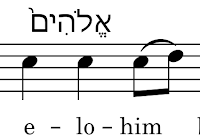I wonder if I have ever written an introduction to this topic: The music embedded in the text of the Hebrew Bible.
I have certainly done the 60 second elevator pitch. And people nod politely, and sometimes show real interest. I have also written and explained how it works - but that's like taking a music lesson, and people might want to just listen.
But let's say you have had the elevator pitch and you want to take the time to actually hear performances and get a real sense of what it is like and the extent of variation that is possible even within the limits of the deciphering key. I think the music page says to you - here it all is, find the specifics for yourself. That's not such an easy job. So here's the 40 minute intro.
Start at the beginning. [But you can of course hear these in any sequence you like] Here is a full 12 minute performance of the first chapter of Genesis. The performer is the French soprano, Esther Lamandier. Ah - I hear the problem. It's all in Hebrew. And it's not traditional. So if you are familiar the chanting of the synagogue, it will be a strange melody. And if you are not, it will sound like nothing you may ever have heard.
But listen - and if you read music, here is a score.
Next I would have you hear an English version of Isaiah 12, the psalm for the lectionary (Year C, 23rd Sunday after Pentecost.). This is arranged for cantor, choir, and congregation. This performance was four years ago at St John the Divine, Victoria. The setting was used again this past year. The choir is under the leadership of David Stratkauskis. The cantor was Anne van der Sloot.
So you can see that there is some potential for the usage of this ancient music today. The score is here.
Now for something quite different, this is the elegy (4 minutes) that David wrote on the death of Saul and Jonathan, performed on public radio sometime in the '90s. Did David sing it this way? I certainly can't say. But someone composed it for this passage of 2 Samuel. And it fits.
As an illustration of how the music can be developed and arranged, I have done a few psalms that have been performed each with a brief introduction to the deciphering key of Suzanne Haïk-Vantoura. Both these are sung by the Choral Scholars of St John the Divine, Victoria, BC, Canada under the direction of David Stratkauskis.
Psalms 145, verses Ket to Samekh, (8-14) (7.5 minutes) and Psalms 100. (7.5 minutes)
Finally, I invite you to hear a robust performance of Psalms 29 (3 minutes) performed by Chanticleer on public radio. Original score here. My arrangements are tame compared to this. I haven't dared to work with that particular mode.
Much more is available to researcher, composer, or performer. I myself have not heard all that there is to hear. It's time I did.


